Are you planning to earn a passive income online? Planning to start a blog? Are you confused about which blogging platform to choose when you have so many options?
In this article, I will try to clarify all your confusion and discuss the Best Blogging Platforms for making money.
In this article, we will list the significant positives and negatives of a couple of blogging platforms (both paid and free) so that it is easy for you to decide which is the Best Blogging Platform for you.
Unfortunately, no blogging platform can satisfy all your requirements, and you may need to make a compromise.
What is a Blog?
A blog is a discussion or informational website published on the World Wide Web consisting of discrete, often informal diary-style text entries. Posts are typically displayed in reverse chronological order, with the most recent post appearing at the top of the web page.
The popularity of blogging started over a decade ago. People are now more focused on building options to earn passive income apart from regular jobs.
You need a blogging platform to create and run a blog. You can develop our blogging platform if you want, but that costs a lot of money and takes a lot of time. No one would like to go that way except for big publication houses.
What is your Goal in Blogging?
Many people jump into blogging just because others are jumping into it. That does not make any sense; sooner or later, they realize their mistakes. You should blog only if you love to blog.

Choosing a good blogging platform vastly depends on your goal and expectations for blogging.
For example, if you want to earn money from blogging through ads, choose a platform that supports third-party ad support.
If you want to earn money through affiliate marketing, you should choose a blogging platform that offers affiliate features.
Before choosing a blogging platform, you need to decide on your monetization strategy and the goals you want to achieve.
Hers is a list of common goals that most bloggers usually have.
- Wants to earn a passive income
- Wants to become famous
- Wants to connect with people
- Wants to promote a brand
Know Your Capabilities
Well, it’s very important to know your capabilities before choosing a blogging platform. Some platforms are great, but you need to have a fair amount of technical knowledge to get them moving.
On the other hand, some platforms offer everything out of the box. Choosing a blogging platform based on your capabilities can prevent future issues.
Below are a few questions that you should ask yourself before choosing the best blogging platform for yourself.
- Do I have a basic knowledge of coding?
- Do I know how to host a website?
- Do I have enough funds for premium platforms?
- Do I have enough digital marketing skills?
- Can I give you enough time to grow my blog?
How To Choose The Best Blogging Platforms?
If you want to choose the best blogging platform, you need to make a checklist of criteria based on which you will make a decision.
Interface
That makes a lot of sense for newbies as they may not have enough knowledge to navigate around.
An intuitive interface with easy-to-use navigation is handy when choosing the best blogging platform.
Customization
Usually, all free blogging platforms come with a very basic outlook. No one likes the basic look, and you may want to change it right away.
But does the platform offer a high level of customization? Look for this before choosing your best blogging platform.
Themes
Theme is a great way to change the look of your blog. You should consider how versatile the theme options are for the platform you are using.
Also, you need to look at how costly those themes are or whether we have enough free themes in case you are out of budget.
Plugin
A blogging platform without enough plugins is just not right. The blogging business is getting competitive daily, and you need a few outstanding plugins to grow your blog to the next level.
Optimization
An under-optimized blog is of no use. You will have to optimize your blog for speed and SEO. Without these, you can’t rank on Google. So, look for a platform that offers you the optimization option.
Flexibility
When you start a blog, you start from zero. But does your best blogging platform offer flexibility when your blog grows? Flexibility in terms of growth and geographical presence are very important.
Modularity
No one likes a rigid blogging platform. You may start with a traditional blog, but later, you may want to integrate affiliate products or e-commerce.
Does your platform have this modularity? If you think about a long-term goal, modularity is a must in blogging platforms.
Monetization
Here comes the main part. Most bloggers do blogging either for a passive income or for a full-time income. Your monetization strategy is very important before choosing a blogging platform.
Monetization can be achieved through advertisements, paid articles, and selling affiliate products or services. Your best blogging platform should offer all these options.
Types of Blogging Platforms
A blogging platform can be categorized broadly into two types.
Free Vs Paid
Almost all blogging platforms are free to use. However, you may need premium themes and plugins.
It’s better to choose a free blogging platform so that you don’t have to invest too much money in the initial period of your blogging journey.
Self Hosted Vs Platform hosted
Some platforms offer blogging software so that you can self-host your blog, while others offer to host your blog on their servers. Both have advantages and disadvantages.
You will have full control of the self-hosted blog and can use your domain name. However, you must pay for the domain name and hosting.
In the case of a platform-hosted blog, you can’t use your domain name ( Exception available), and usually offers limited features.
One good thing about a platform-hosted blog is that you don’t need to pay for hosting unless you want to choose their premium plans.
Now that we know what blogging is, what our goal is, and how to choose a blogging platform, let’s compile a list of the Best Blogging Platforms.
Table of Contents
1. WordPress.Org
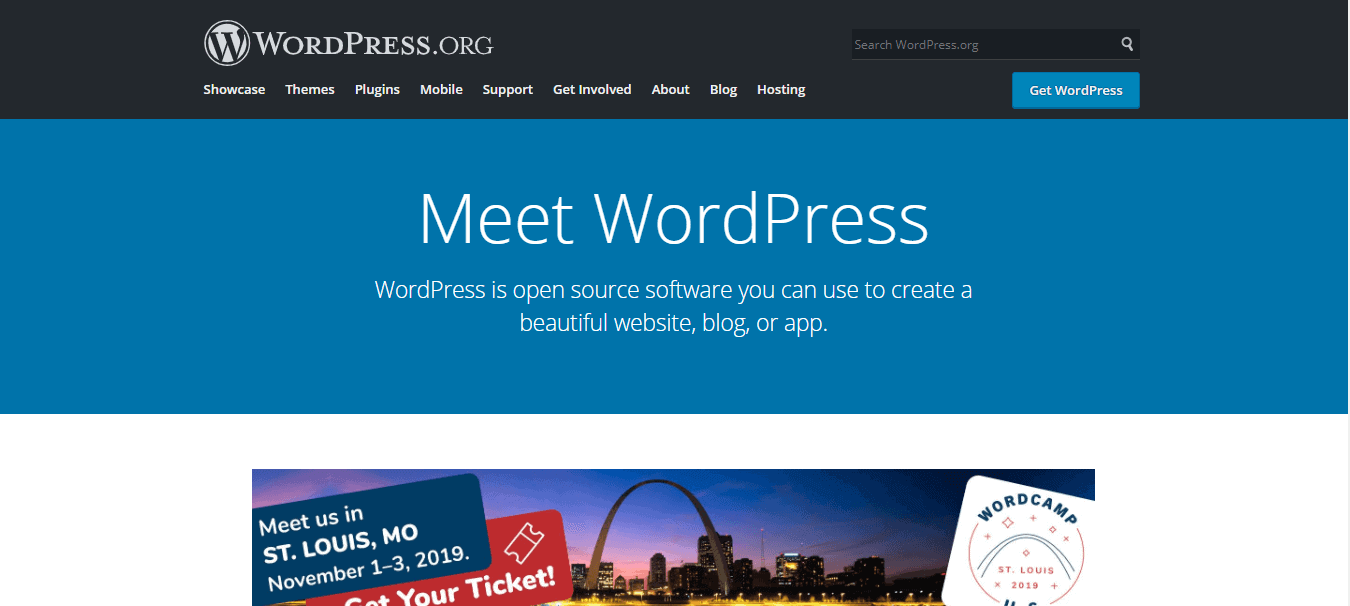
First of all, please don’t get confused between WordPress.org and WordPress.com.
WordPress.org is blogging software for self-hosted blogs, whereas WordPress.com allows you to create a blog on its subdomain.
You can use the WordPress blogging software for free and host your blog anywhere you want. You need to buy a domain name and a hosting plan.
In the case of WordPress.com, you host your blog under a subdirectory of WordPress.com. You will no longer need to buy a domain name or a hosting plan.
As you can see, WordPress powers over 60% of blogs. It is one of the most popular and widely used blogging platform software, and it is undoubtedly the best free blogging platform available.
You need to buy a domain name and have to rent a hosting space to host a blog if you want to use WordPress.
Once you have purchased a domain name and hosting, you need to install WordPress, which is straightforward.
Growing your blog in WordPress requires some learning, but it is not difficult for casual bloggers.
WordPress is the best solution if you want to control your blog fully. You can design the blog using many free and paid themes.
You can also enhance the functionality of your blog by using plugins.
WordPress offers community-based support, so it is very unlikely that you will get an answer to your query.
There is a support section for all plugins and themes where you can ask questions, and the authors are prompt enough to answer them.
Key Aspects Of WordPress.org
Pricing
WordPress software is free to use and modify. However, to host a blog with WordPress, you need to buy a domain name, which costs about $10 per year.
You also need to buy a hosting package, which usually varies based on your requirements.
Typically, the lowest plan starts from a dollar and goes to hundreds of dollars for a premium plan.
On average, if you spend about $20- $30 per month, you can have a well-performing blog.
Customization
You can customize every aspect of WordPress to suit your needs. You can install themes to change its appearance and plugins to enhance its capabilities.
WordPress source codes are freely modified, so you can do anything you want with WordPress.
Monetization
Monetization can be activated using Google AdSense or you can use any other Ad network based on your requirement.
You can also implement paid promotions, integrate affiliate marketing, and even build an eCommerce website to earn money.
Branding
Since you are hosting a self-hosted blog, you can customize your branding, including your logo, brand templates, color scheme, etc.
Also, using a custom domain will increase the brand popularity of your blog.
Suitable For
WordPress is suitable for beginners as well as experienced bloggers. However, there is a fair learning curve.
WordPress.Org Positives And Negatives
Positives
- Free to use and modify
- More than 50K free plugins and themes are available
- Good community based
- Can be used for any type of websites
- Multiple monetization options
- Frequent updates
Negatives
- You need to learn to get the best out of WordPress
- You need to buy premium themes and plugins to create a performing blog.
- You need to pay for the domain and hosting.
- You will have to manage your backup and security
2. WordPress.Com

WordPress.com is a blog hosting service that was started in 2005. It allows authors to host their blogs for free or pay a yearly rent to get premium service.
You can start your blog on wordpress.com for free. But you have to use their subdomain.
For example, if you host a blog on WordPress.com, your domain name will be like https://yoursite.wordpress.com.
In the free plan, you cannot monetize your blog, and WordPress will show its ads. The worst part is that you won’t earn anything out of the ads that WordPress.com shows on your blog.
So, if you plan to earn money from your blog, avoiding the WordPress.com free plan is better.
In the free plan, you can’t even install a theme or a plugin to change the look and functionality of the blog, and there is no support available for free plan users.
If you decide to try their paid plans, only the business plan, which costs about $25 per month, makes sense.
You can use your domain and 200 GB of disk space and you can use custom themes and plugins.
You will have access to all premium themes, which is good. SEO tools and Google Analytics can also be integrated.
You can run your ads or integrate Google AdSense to earn money. You can run your affiliate marketing campaign and sell custom services.
If you plan to run an e-commerce store, you will need to choose their eCommerce plan, which costs $45 per month.
Key Aspects Of WordPress.com
Pricing
If we exclude the free plan, the paid plan starts at $5 a month for a personal plan and $45 a month for an eCommerce plan.
Beginners can start with the $5 plan and can settle for a $25 business plan, which has almost all the features of a self-hosted blog.
Customization
Customization is only available in the premium and business plans. If you choose the business plan, you will have access to all free and paid themes.
Monetization
You can run your ads or Google AdSense ads only from the premium plan onwards. You can also run your affiliate marketing campaigns in the business plan.
Branding
Only the premium plan allows you to have your brand logo. You can also choose a custom theme and modify it to fit your branding.
Suitable For
If you don’t know how to host a website or don’t want to spend time hosting and designing a blog, then wordpress.com is the best place to start your blog.
WordPress.Com Positives And Negatives
Positives
- The free plan is enough to start with
- No need to buy a domain name and hosting
- You can use Google AdSense
- You can do affiliate marketing
- Speed optimized
Negatives
- The only best plan (Business) is very costly
- Very limited customization option
- WordPress can terminate your account anytime if they feel like doing so.
3. Blogger.Com
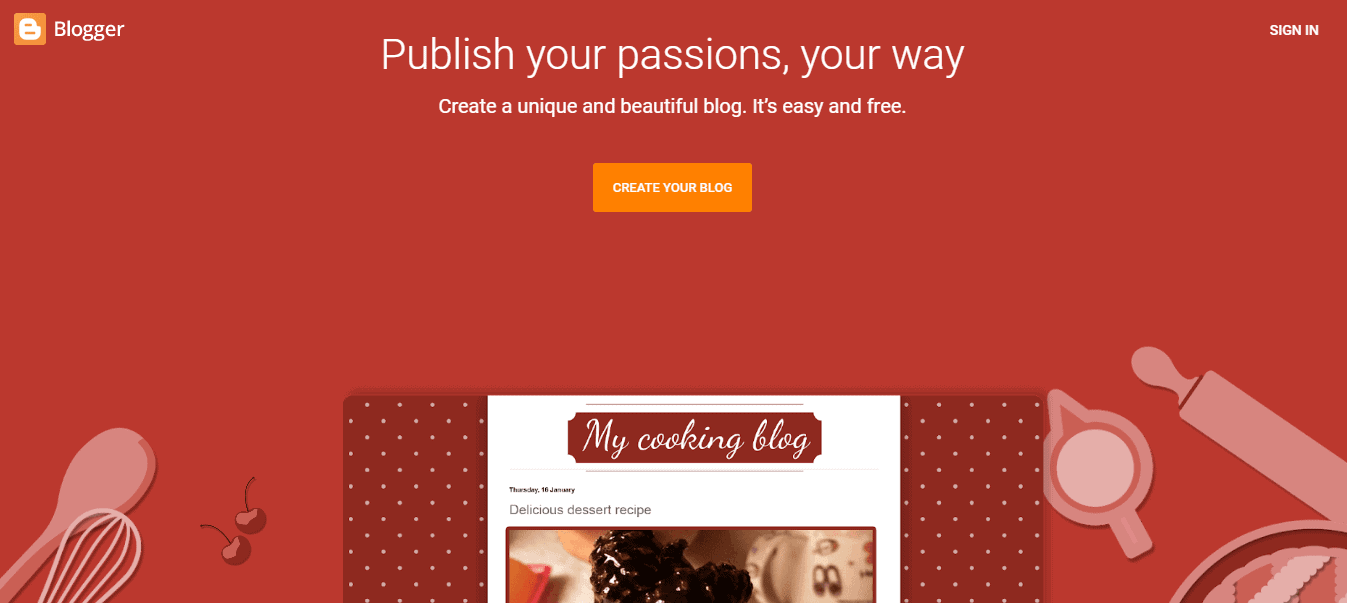
You will hardly find any blogger who never used blogger.com. In fact, in early 2000, blogger.com was the only platform where you could have tried your blogging desire.
Started in 1999 by Pyra Labs, which was later acquired by Google in 2003, Blooger.com is one of the oldest free blogging platforms that is still popular.
The feature that makes blogger.com stand out from the crowd is that it is completely free to use. If you have a Google account, you are good to go to start your blogging journey within a minute with Blogger.com.
You can customize your blogger.com blog with plenty of templates, and there are a number of other tools available to give your blog a professional look.
You can start using the Blogger subdomain to host your blog, or you can buy a domain name of your choice from any domain registrar and link it to your blogger.com account.
You can’t remove the blogger.com branding from your blog. But if you use a custom domain name, it’s very difficult to figure out if it was hosted on blogger.com or not.
Regarding monetization, you can always add Google AdSense to your blog and integrate Google Analytics to see a snippet of traffic flow.
You can even sell services or products using the blog hosted on blogger.com.
If at any point you feel that blogger.com no longer meets your needs, several plugins can help you migrate your blog to WordPress or another platform.
This flexibility helps people start their blog on blogger.com and then move to another platform when the blog grows.
Key Aspects Of Blogger.com
Pricing
Blogger is free to use, and no premium plans are offered. The free plan has everything that a beginner needs to start their blog.
Monetization
You can use Google AdSense to monetize your blog. You can run affiliate marketing tools, too. At present, Google does not offer any other ad networks to show their ads on blogger.com blogs.
Customization
There are several free templates and plugins available to customize the look and functionality of your blogger.com blog.
Branding
If you buy a custom domain and link it to a blogger.com blog, you can use your branding. At first glance, no one will even notice whether your blog is self-hosted or blogger. com-hosted.
Suitable For
It is suitable strictly for beginners, as blogger.com underperforms when your blog grows. Numerous tools and plugins required to grow your blog cannot be used on blogger.com.
Blogger.Com Positives And Negatives
Positives
- Free to use
- You can use Google Adsense
- No need to buy a domain name and hosting
- Powered by Google server
Negatives
- Very limited features
- You can not use any third-party ad network
- Updates are not very frequent.
4. Medium

Medium is the most underrated blogging platform. Medium is not available for everyone. You need to buy their monthly plan to read articles. That is one of the main reasons that medium is not that popular among the bigger audience.
The medium was started in 2012 and is mainly focused on premium audiences who love to read premium articles at a price. Depending on the number of articles you want to read, you need to pay around $5- $50 per month.
As a premium member, you will get ads-free articles, daily emails containing article links of your choice, a monthly newsletter, etc.
If you have trouble reading, you will also receive an audio version of the articles. This is a stand-alone feature that helps visually impaired audiences enjoy their favorite articles.
As far as monetization is concerned, you cannot add AdSense or any other ad network. You can not run an affiliate marketing promotion or sell a service.
The only way to earn money is by writing good content and getting claps from audiences. You will be paid based on the claps you receive and the number of times your article is viewed.
Medium pays a portion of readers’ subscription amount to authors, so they are motivated to write.
Signing up in Medium is very straightforward. You can use your Google login to sign up. You won’t get any customized blog page for your medium account. But instead, it will be a profile page.
You can sign up for their publication agency tool, which allows you to have a webpage like “https://medium.com/your user name”
It gives a professional look to your medium account. For authors, there is no limit on how many articles they can publish in a month.
At present, Medium only allows USA writers to earn money, as you need a social security number to do so.
You also need a Stripe or PayPal account to receive money. Medium uses its analytics tools, which show monthly visits, claps, and earnings for a paid post.
You can connect your WordPress blog to Medium and publish the same article on WordPress and Medium.
Hey, don’t worry.
You don’t get punished for duplicate content. All article published from WordPress to Medium has a canonical URL that shows that your WordPress blog is the owner of the article.
If you want to know how to auto-publish your WordPress blogs to Medium, you can try the blog2social plugin.
Medium has a great readers database. So, you can expect a good amount of traffic to your blog.
Also, I have observed that articles shared on Medium get ranked quickly. There are instances when my WordPress articles are not ranked, but the same articles shared on Medium get ranked.
Key Aspects Of Medium.com
Pricing
Free to use as a writer. If you want to read, you need to pay a minimum of $5 to a maximum of $50
Customization
No customization apart from having a publication page that does not look bad at all.
Monetization
You can join the medium partner program to earn money when someone visits your post and gives you a clap. However, third-party ads and Google Adsense are not allowed.
Branding
No branding option apart from using your logo.
Suitable For
Sign up for Medium only if you can write premium articles. Otherwise, stay away from it. Readers do not like poor articles after paying a hefty subscription fee.
Medium Positives And Negatives
Positives
- Very intuitive interface
- No ad network is needed
- Subscription-based earning
- Pays more than other networks
Negatives
- No AdSense
- No customization or branding option
- You only need to be in the US or a US citizen to earn from it
5. Tumblr

Tumblr is one of the most popular microblogging platforms, and it is primarily targeted at younger audiences.
Rather than a text-based blog, Tumblr focused on graphics and a media-based blog. Social networking is integrated into Tumblr. So you won’t be having any issues getting more traffic to your blog.
When you register on Tumblr, you will be given a subdomain like “https://yoursite.tumblr.com.” If necessary, you can buy a domain name and connect it to a Tumblr blog to give it a professional look.
There are also a lot of customization tools to change the look of your Tumblr blog.
Tumblr allows you to integrate AdSense into your blog. You can also use another ad network if required.
You can share your affiliate links on the Tumblr blog. However, please note that sharing too many affiliate links is considered spamming, and your account may be banned for that.
Key Aspects Of Tumblr
Pricing
Tumblr is free to use. However, you can buy a custom domain and connect to Tumblr to give it a more professional look.
Customization
Tumblr has several free templates which can be used to customize the blog.
Monetization
You can use Google Adsense or any third-party ads for your blog. You can also earn from affiliate marketing.
Branding
Not much option to show off your branding apart from connecting your Tumblr blog to a custom domain.
Suitable For
This platform can be used by beginners to advanced users to generate traffic. The best option is to share WordPress posts on Tumblr and get referral traffic.
Tumblr Positives And Negatives
Positives
- Suitable for microblogging
- No need to buy a domain or hosting
- Huge customer base
Negatives
- Bare basic interface
- Limited monetization options
6. Ghost
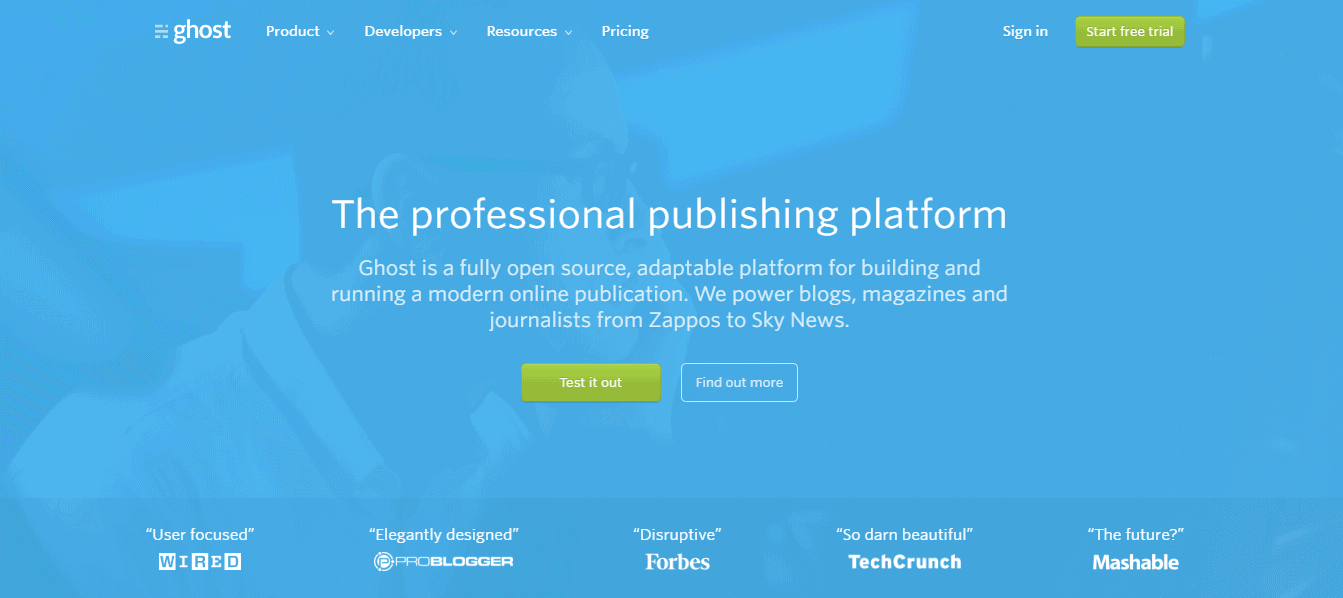
Ghost is a free and open-source blogging software. You can use ghost software to host your blog using a domain name and hosting.
You can also host your blog on a ghost server, saving you the cost of hosting and hosting your domain name. The concept is similar to WordPress.org and WordPress.com
Unlike WordPress, Ghost is purely a blogging platform. You can’t create a static website in Ghost. Although Ghost blogs have a thin audience base, it has been growing in recent years.
Ghost offers many important features out of the box, such as AMP ( Accelerated mobile pages) and SEO. WordPress still lacks these features, and you have to depend on plugins to enable them.
You can upload themes and plugins in Ghost, much like we do in WordPress. However, the repository has limited plugins.
Ghost encourages minimalistic design, which is why ghost blogs load much faster than traditional WordPress blogs.
Key Aspects Of Ghost
Pricing
If you plan to host your blog on the Ghost server, you can do that by paying $10 for the lowest plan and $100 for the highest plan.
Customization
You can customize your blog using a custom theme and plugin just like any other WordPress blog
Monetization
You can use Google Adsense or any other third-party ads on ghost blogs. You can also run affiliate marketing campaigns.
Branding
Just like WordPress, you can change every aspect of your blog and add your branding stuff.
Suitable For
For newbies and casual bloggers, this platform is not that popular yet.
Ghost Positives And Negatives
Positives
- Very clean and fresh interface
- AMP support out of the box
- Theme and plugin support
Negatives
- Limited options for monetization
- Bare basic design
7. Linkedin

Many of us have been using LinkedIn for a long time to build our professional channels. However, we may not be aware that LinkedIn also serves as a blogging platform.
Due to the huge user database, your blog will rank quickly if posted on LinkedIn.
You can post a blog on your profile or create a business page and post your articles there.
You can’t do much customization other than adding your logo and banner. You don’t have any option to connect your LinkedIn profile to a custom domain.
You can share your WordPress post on LinkedIn to get referral traffic. WordPress offers the ability to share WordPress posts directly with LinkedIn using the Jetpack plugin.
If you have more connections, your post will rank very quickly compared to the original post.
Key Aspects Of LinkedIn
Pricing
LinkedIn is free to use. Paid plans are available, but they are useless from a blogger’s point of view.
Customization
No customization other than your profile image and banner.
Monetization
You cannot earn directly from LinkedIn. You can share affiliate links, sell services, and take coaching or seminars to earn money.
Branding
Not many branding options are available on LinkedIn.
Suitable For
It is not suitable purely for blogging, but if you share WordPress posts on LinkedIn, you can get referral traffic.
LinkedIn Positives And Negatives
Positives
- Best suited for job-based blog
- Huge user base
- Free to use
Negatives
- No direct option for monetization
- No branding option
8. Weebly
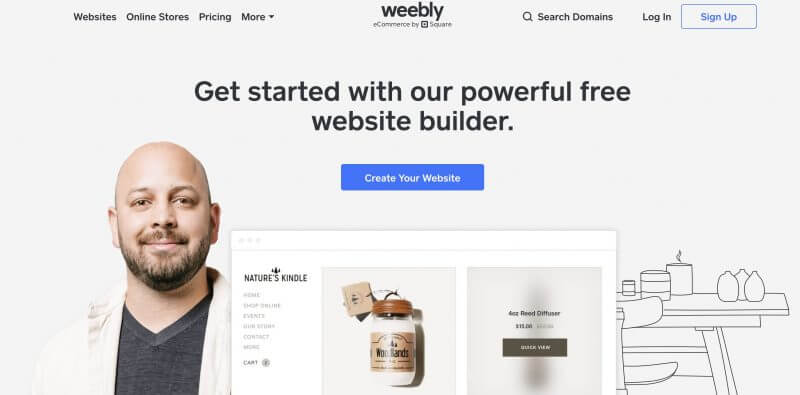
Weebly is an online website builder. Unlike WordPress, which requires you to download the software and use other page builder tools to create a blog, Weebly has a list of features for creating a blog.
Weebly offers everything with a drag-and-drop option. The interface is also very intuitive, and any casual blogger can create a blog on Weebly.
Powerful blog SEO tools and analytics are preinstalled in Weebly, and you can customize your Weebly blog with a wide variety of themes and plugins.
I have hosted a static website with Weebly for the last 10 years, and I must say it’s super easy to create a website on Weebly.
However, if you want to take your blog or website to the next level, then options are very limited.
When you sign up on Weebly, you are automatically allotted a free plan. Fortunately, the free plan does not have annoying ads except for the Weebly branding in the footer.
Weebly offers plans starting from $5 per month for a basic plan and up to $38 per month for an eCommerce plan. All paid plans include a free domain name.
In the paid plan, you can use your branding and use Google Adsense to earn money. You can even use third-party ads and affiliate marketing tools in the paid plan.
Key Aspects Of Weebly
Pricing
Weebly is free to use, but to enable monetization, you need to buy the premium plan, which costs $5 to $38 per month.
Customization
The free plan has enough customization options, themes, and plugins. However, if you are serious about your Weebly blog, you need to choose a paid plan.
Monetization
In the paid plan, you can enable Google Adsense and other third-party ad networks.
Branding
Except for the free plan, all other plans offer enough options to include your branding in the blog.
Suitable For
It is suitable for both experienced and newbie users if they don’t want the hassle of self-hosted blogs.
Weebly Positives And Negatives
Positives
- Free to use
- Can be used for creating online stores
- Payment gateway available
- Easy to use
- Drag and drop website builder
Negatives
- Almost every other feature is only available in the paid plan
- Limited option for earning money
9. Wix
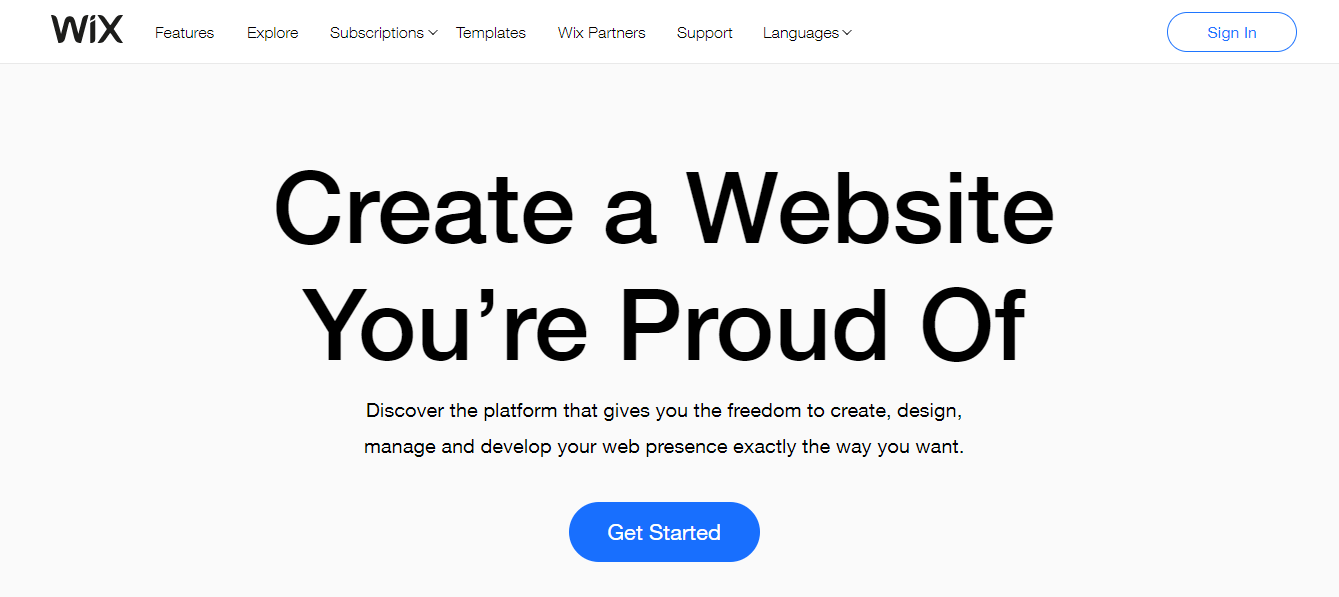
Wix is similar to Weebly in that it is first a website builder and then a blogging platform.
Like Weebly, you can use the drag-and-drop feature to design your blog. You can customize your blog using free themes. There are also numerous free plugins available to enhance functionality.
One of the good things about Wix is that once your blog is live, you can write articles from the front end itself rather than log into the admin dashboard. You don’t need to think about SEO and promotion, as Wix takes care of that.
The free Wix plan comes with a subdomain with Wix ads. Bandwidth and storage are also limited. But if you pay $2 per month for their basic plan, you can connect your domain.
Key Aspects Of Wix
Pricing
Free to use, but to use AdSense, paid plans are required.
Customization
Free themes and plugins are available to customize your blog.
Monetization
Only paid plan offers monetization through Google Adsense
Branding
The paid plan offers the option to have your own branding.
Suitable For
It is suitable for both experienced and newbie users if they don’t want the hassle of self-hosted blogs.
Wix Positives And Negatives
Positives
- One of the best website builder
- One can run Google AdSense
- Drag and drop builder
Negatives
- Plans are costly
- The free version has limited features
10. Squarespace

Squarespace is one of the most popular platforms for hosting a blog. Like Wix and Weebly, it also offers a drag-and-drop function, and you can take your blog live within a minute.
Unlike Weebly and Wix, they don’t have a free plan. You must pay a minimum of $12 a month to use their service.
In the basic plan, you will get a free custom domain with unlimited bandwidth and storage. SEO features are also built-in basic plans.
If you move to a higher plan, you can even host a full-fledged eCommerce website.
Unfortunately, Squarespace does not offer the option to integrate Google Adsense. To get Google Adsense to work, you will have to insert ad codes in the code snippet section.
This makes it less popular for a blogger to try the Squarespace platform.
Key Aspects Of Squarespace
Pricing
Squarespace does not offer a free plan. To use its platform, you must pay a minimum of $12 per month.
Customization
There are limited customization options, as you can not use any third-party themes or plugins.
Monetization
You can not use Google Adsense directly. However, you can use code snippets to insert Google AdSense codes.
Branding
Squarespace has limited branding options, even in the paid plan.
Suitable For
Squarespace is suitable for seasonal bloggers and commercial agencies.
Squarespace Positives And Negatives
Positives
- Very intuitive interface
- Option to use Google Adsense
- Unlimited bandwidth in all plans
Negatives
- Limited customization
- No free plan
Conclusion: Best Blogging Sites
Well, without a second thought, I would recommend using WordPress software from wordpress.org and self-hosting the blog.
If you are low on budget and a newbie, starting with Blogger can be an option. If you have excellent writing skills and live in the USA, you can try Medium to earn extra bucks.
WordPress, Blogger, and Medium require some technical knowledge. If you don’t want to spend that effort, you can try Weebly or Wix.
But again, I would say a self-hosted blog using WordPress software is the best bet for the long term. So WordPress is my Best Blogging Platform.
FAQ | Best Blogging Platform
Which Is The Best Blogging Platform?
WordPress is the best blogging platform, with about 60% market share, followed by Blogger.com
How To Choose The Best Blogging Platform?
You should choose the best blogging platform based on different criteria, as shown below.
Interface
Customization
Flexibility
Modularity
Availability of themes
Availability of plugins
Monetization options